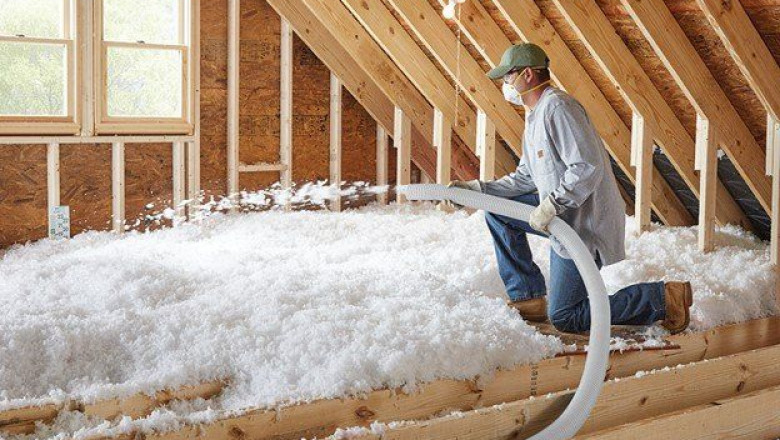views
When it comes to improving home energy efficiency, homeowners often focus on upgrading appliances or sealing windows and doors. While these strategies are important, one of the most effective and often overlooked methods is upgrading your insulation. Specifically, Loose-Fill Insulation offers a flexible and cost-effective solution for both retrofitting older homes and insulating hard-to-reach spaces in new construction.
Loose-fill insulation, typically made from cellulose, fiberglass, or mineral wool, is blown into wall cavities, attics, and other spaces using special equipment. This type of insulation is particularly beneficial in irregularly shaped areas or locations with many obstructions where traditional batt insulation might not fit well. Its ability to conform to any space allows it to create a seamless thermal barrier that reduces air leakage and boosts energy efficiency.
What Makes Loose-Fill Insulation Unique?
Unlike batt insulation, which comes in pre-cut panels, loose-fill insulation consists of small particles that can settle into spaces, filling nooks and crannies. This feature makes it particularly ideal for older homes with uneven framing or for insulating over existing material.
There are two primary types of loose-fill insulation: cellulose and fiberglass. Cellulose insulation is made from recycled paper products and treated with fire retardants. It's considered one of the most environmentally friendly options on the market. Fiberglass loose-fill, on the other hand, is made from molten glass spun into fibers and is known for its resistance to moisture and mold.
Key Energy Efficiency Benefits
The ability of loose-fill insulation to create a tight seal can lead to significant energy savings over time. Heating and cooling typically account for a large percentage of household energy bills. By improving the thermal envelope of a home, loose-fill insulation reduces the amount of heated or cooled air that escapes, allowing HVAC systems to work more efficiently.
Additionally, the effectiveness of insulation is measured by its R-value, which represents its resistance to heat flow. Loose-fill cellulose can offer R-values ranging from R-3.2 to R-3.8 per inch, while loose-fill fiberglass ranges from R-2.2 to R-2.7 per inch. When properly installed, both can meet or exceed local building code requirements for energy efficiency.
Application in Attics and Retrofits
Attics are one of the most common areas where loose-fill insulation is used. Because heat rises, poorly insulated attics can become a major source of heat loss in the winter. Loose-fill insulation can be easily blown into attics over existing insulation, improving performance without the need to remove what’s already there.
In retrofit situations, such as upgrading insulation in existing walls, loose-fill materials can be blown in through small holes drilled into the wall cavities. This minimally invasive approach allows homeowners to improve their insulation without undergoing major renovation work.
Environmental Considerations
Many homeowners today are seeking sustainable solutions for their homes. Loose-fill cellulose insulation meets that demand by using up to 85% recycled content, primarily newspapers and other paper waste. Additionally, the energy required to manufacture cellulose insulation is much lower compared to fiberglass, making it a more eco-friendly option.
Fiberglass insulation, while not as green in terms of production, does offer durability and resistance to pests and mold, which may appeal to homeowners in more humid climates.
Safety and Performance
Fire resistance is a common concern when discussing insulation materials. Fortunately, both cellulose and fiberglass loose-fill insulations are treated to meet fire safety standards. Cellulose is often treated with borates, which not only provide fire resistance but also offer pest control benefits.
Proper installation is key to performance. Uneven distribution or underfilling can compromise thermal performance. For this reason, it's often best to rely on professionals with experience handling loose-fill materials.
Cost Considerations
While loose-fill insulation is competitively priced, the cost will vary depending on the size of the space and the type of material used. Generally, cellulose tends to be slightly more affordable than fiberglass. However, both offer a relatively quick return on investment thanks to the energy savings they provide over time.
Moreover, various rebates and incentives are often available for homeowners who upgrade their insulation, especially when aiming to meet ENERGY STAR® or local energy efficiency standards.
Choosing the Right Insulation Service Provider
Choosing a qualified contractor is crucial when installing any type of insulation. A skilled professional will assess the needs of your home, calculate the appropriate R-value, and ensure the material is evenly and adequately distributed.
Companies that specialize in insulation services are more likely to use the proper equipment and techniques for optimal results. They can also help guide homeowners on which type of loose-fill material is best suited to their climate, budget, and sustainability goals.














Comments
0 comment